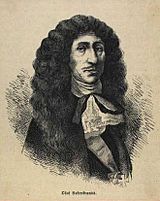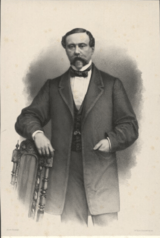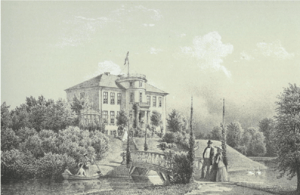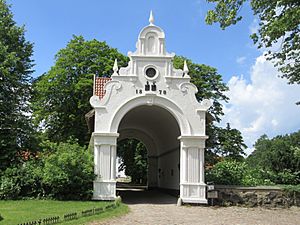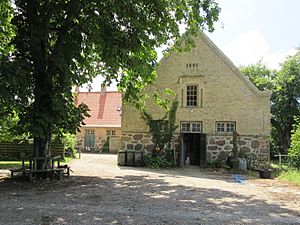Egholm, Lejre Municipality facts for kids
Quick facts for kids Egholm |
|
|---|---|
 |
|
| General information | |
| Architectural style | Neoclassical |
| Location | Trehøjevej 45 4070 Kirke Hyllinge |
| Country | Denmark |
| Coordinates | 55°45′58.42″N 11°43′44.67″E / 55.7662278°N 11.7290750°E |
| Completed | 1812 (main building) |
Egholm is a beautiful old manor house and a large estate located on the Hornsherred Peninsula in Denmark. It's about 60 kilometers west of Copenhagen. The main building, built in 1824, has a fancy style called Neoclassical.
Many of Egholm's buildings are very old and important. They are protected by the Danish government. These include the main house, a gatehouse, a barn, a stable, and even an old horse mill. Today, one of the buildings is home to the Egholm Museum, which is all about weapons and history. The entire estate is huge, covering 770 hectares of land.
Contents
A Look Back in Time: Egholm's History
=The Very Beginning (13th Century to 1640)
Egholm has a long history, going all the way back to the 13th century. You can still see parts of an old Romanesque castle there. People believe it was built for Jacob Nielsen, who was a count and a grandson of a Danish king named Valdemar II. In the 1960s, a hidden vaulted cellar was found!
Egholm was first written about in 1405. Over the next two centuries, many different noble families owned the estate. These families included the Podebusks, Grubs, Dues, Haks, and Krafses. Each family left its mark on Egholm.
Powerful Families: Rosenkrantz and Skeel (1640 to 1804)
In 1640, a very rich nobleman named Holger Rosenkrantz bought Egholm. After he passed away, his son Oluf Rosenkrantz took over. Oluf made the estate even bigger by buying many more farms. He even created a new manor called Krabbesholm from part of Egholm's land.
Oluf Rosenkrantz became a "Friherre," which is a special noble title. Egholm also became a "birk" in 1671. This meant it had its own independent court and rules, separate from the king's. Later, Oluf had to give his estates to his daughters and their husbands. Egholm went to Mogens Skeel.
After Oluf and his wife passed away, Egholm was sold to Mogens Skeel's brother, Otte Skeel. He also bought more land for the estate. Later, Egholm was passed down through the Skeel family and then to Iver Rosenkrantz, who already owned several other large estates.
Iver Rosenkrantz's son, Christian Rosenkrantz, continued to expand Egholm. He owned many estates, including Krabbesholm. Eventually, Egholm was sold to different owners, including Christian Conrad Sophus Danneskiold-Samsøe and Lars Lassen.
The Haffner Family Era (1812 to 1920)
In 1812, Johan Wolfgang Haffner bought Egholm. He decided that the estate should become a "stamhus" for his family. A "stamhus" was like a family trust, meaning the estate would stay in the Haffner family for generations. His son, Wolfgang Haffner, officially set this up in 1831.
Wolfgang Haffner also built the beautiful new main building that you see today. He planted more forests and sold off some of the tenant farms to the farmers who worked on them.
After Wolfgang Haffner's death in 1887, his eldest daughter, Amalie Haffner, inherited the estate. Later, her younger sister, Ebba Wilhelmine Haffner, and then Ebba's son, Erik Alfred Wolfgang Haffner Piper, became the owners.
Egholm Today (1920 to Present)
In 1919, new laws changed how "stamhus" estates worked, so the Haffner family trust was ended. The main building and its park were separated from the farm buildings and sold. Axel Kaufmann bought the main building, and later, Baroness Henny Caroline Wedell-Neergaard owned it.
In 1988, Ole Falck, whose great-great-grandfather founded the famous Falck emergency services company, bought the main building. He later bought back the old farm buildings and most of the land that once belonged to the Egholm estate.
Egholm's Architecture
The main building of Egholm is designed in the elegant Neoclassical style. It's a simple, two-story building with white walls. It has a rounded section facing the garden, which looks very grand. The windows and doors are framed with sandstone, and the roof is made of black-glazed tiles.
Many of Egholm's historic buildings are officially protected. These include the main building (from 1824), the gatehouse (from 1870), a barn (from 1880), a stable (from around 1890), and an old horse mill. They are all important parts of Danish history.
The Egholm Estate and Its Surroundings
The Egholm estate covers a large area of 570 hectares, including the Egholm Forest. Nearby, you'll find Egholm Skovgård and Egholm Møllegård, which were once part of the estate. Inside the forest, there are two ancient burial mounds from the Bronze Age, showing just how old this area is! Some of the buildings on the estate are now used as an equestrian center, where people can ride horses.
Egholm Arms Museum
The Egholm Museum opened in 2012. It showcases Ole Falck's amazing collection of firearms and military items. The museum starts with exhibits about Danish and German soldiers and equipment from the occupation of Denmark during World War II.
You can also see displays about British, Russian, and American troops from that time. The World War II section finishes with an exhibition about the brave Danish resistance movement.
Another exciting part of the museum is dedicated to the Wild West! Here, you can see a real stagecoach, a stuffed bison, old weapons, and other items from that era. There's also a large collection of hunting weapons and gear, including a display of a poacher's home. The museum even has historic weapons dating back to the 17th century.
Who Owned Egholm?
- (1405–1419) Predbjørn Podebusk
- (1419–1435) Henning Podebusk
- (1435– ) Claus Podebusk
- (1436– ) Hans Grubendal
- (1460– ) Jens Due
- ( –1484) Niels Mogensen Hak
- ( –1501) Ejler Mogensen Hak
- (1501–1534) Anne Nielsdatter Hak
- (1534v1539) Christoffer Hak
- (1539–1564) Lene Krafse née Hak
- (1564–1599) Eiler Krafse
- (1599–1602) Hilleborg Bille
- (1602–1620) Christoffer Krafse
- (1620– ) Dorte Andersdatter Krafse née Banner
- ( –1633) Otto Krafse
- (1633) Henrik Holck
- (1633–1639) Hilleborg Holck née Krafse
- (1639–1640) Otto Krafse
- (1640–1647) Holger Rosenkrantz
- (1647–1684) Oluf Rosenkrantz
- (1684–1685) Mogens Skeel
- (1685–1695) Otte Skeel
- (1695–1719) Otto Krabbe
- (1719–1737) Birgitte Krabbe née Skeel
- (1737–1745) Iver Rosenkrantz
- (1745–1763) Charlotte Amalie Rosenkrantz née Skeel
- (1763–1802) Frederik Christian Rosenkrantz
- (1802–1804) Niels Rosenkrantz
- (1804) Marcus Gøye Rosenkrantz
- (1804–1806) Christian Conrad Sophus Danneskiold-Samsøe
- (1804–1809) Lars Lassen
- (1809–1812) Harald Rothe
- (1809–1812) Christian Rothe
- (1812–1829) Johan Wolfgang Reinhold Haffner
- (1829–1887) Wolfgang Haffner
- (1887–1902) Amalie Langenau née von Haffner
- (1902–1914) Ebba Haffner Piper
- (1914–1920) Erik Carl Alfred Haffner Piper
- (1920–1938) Axel Otto Tage Niels Basse Kauffmann
- (1938–1954) Henny Caroline Wedell-Neergaard née Moltke
- (1954– ) Alex Christiani
- (1988– ) Dorrik Aps, v. Ole Falck
See also
- Krabbesholm


